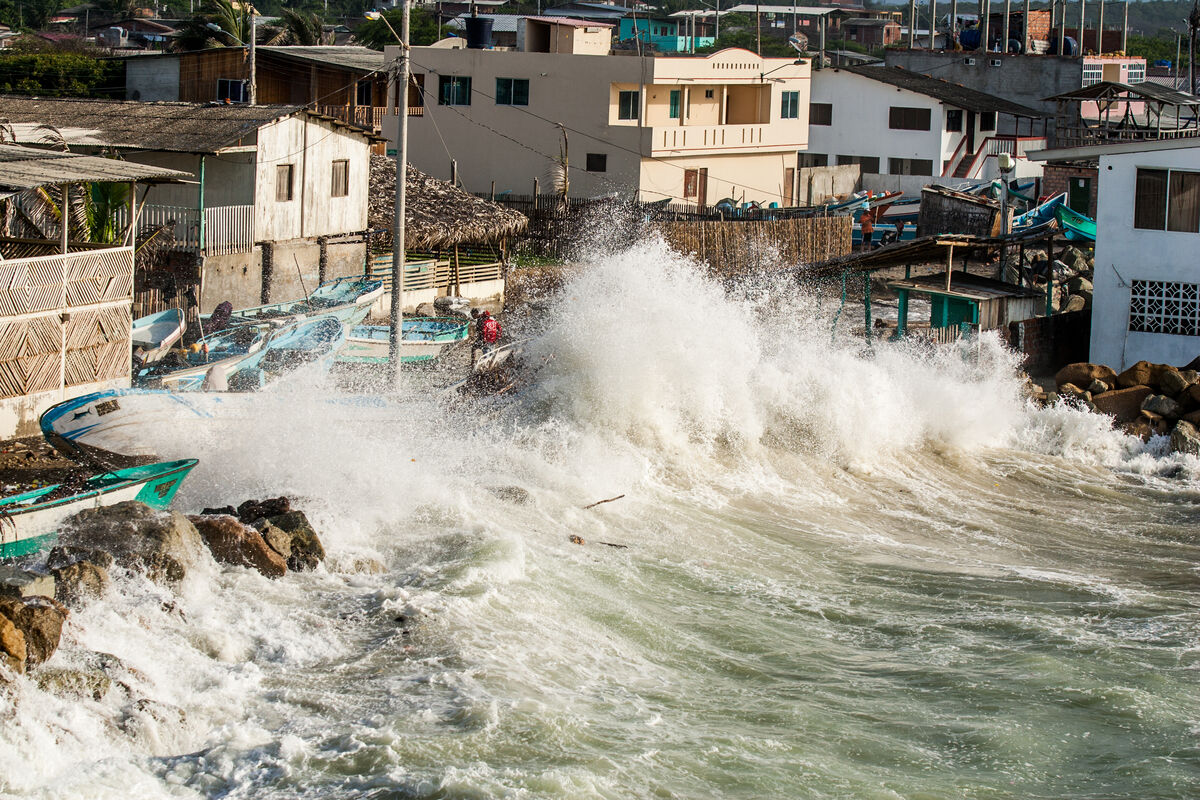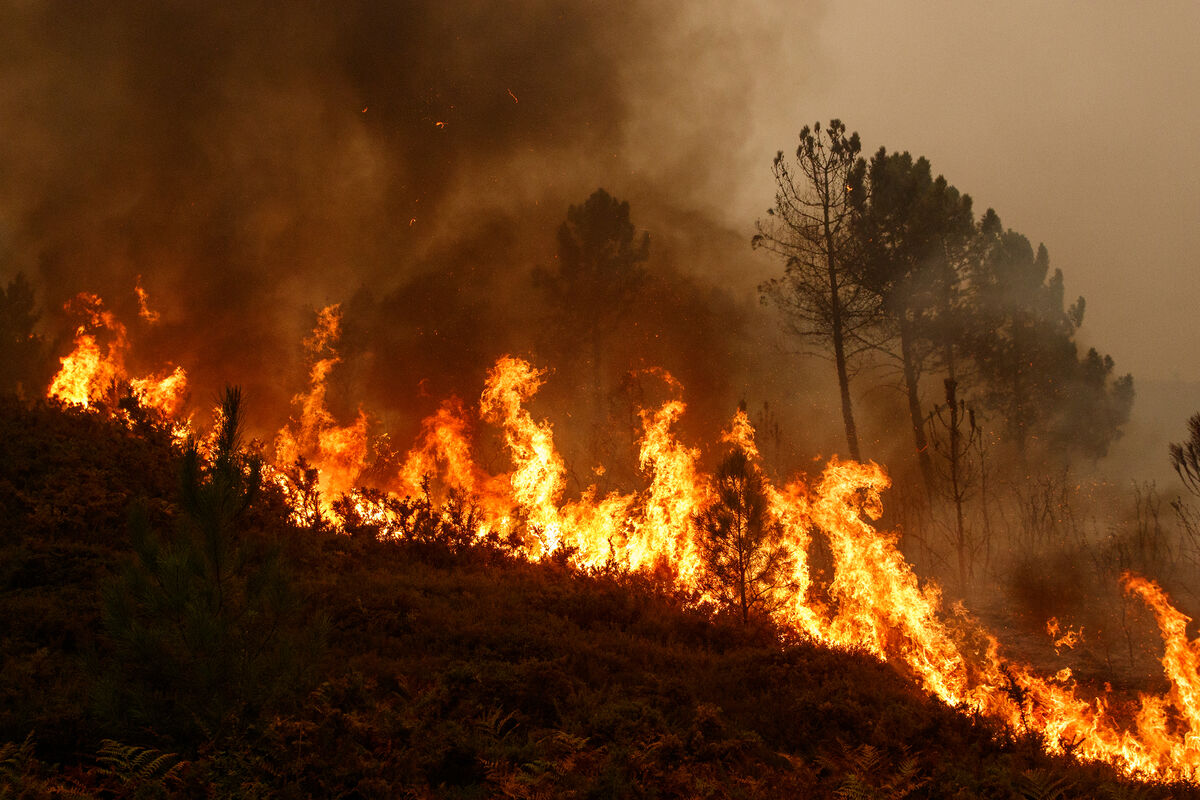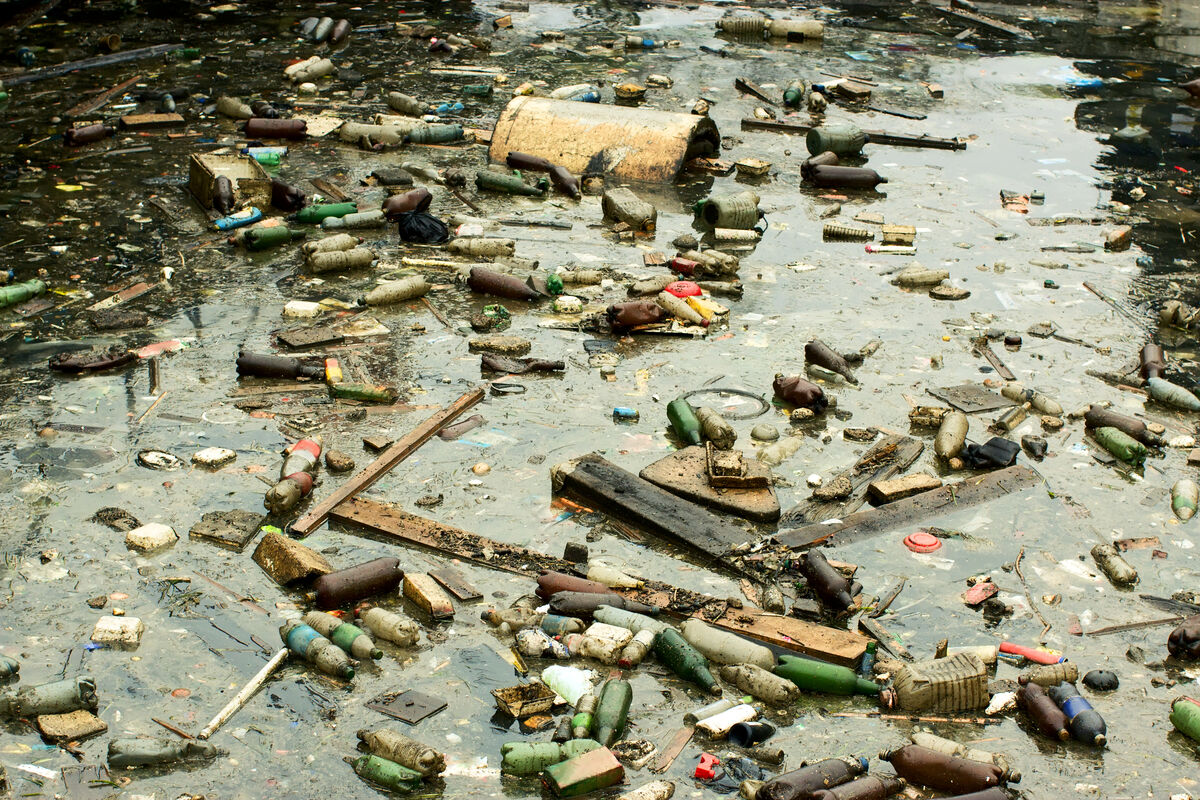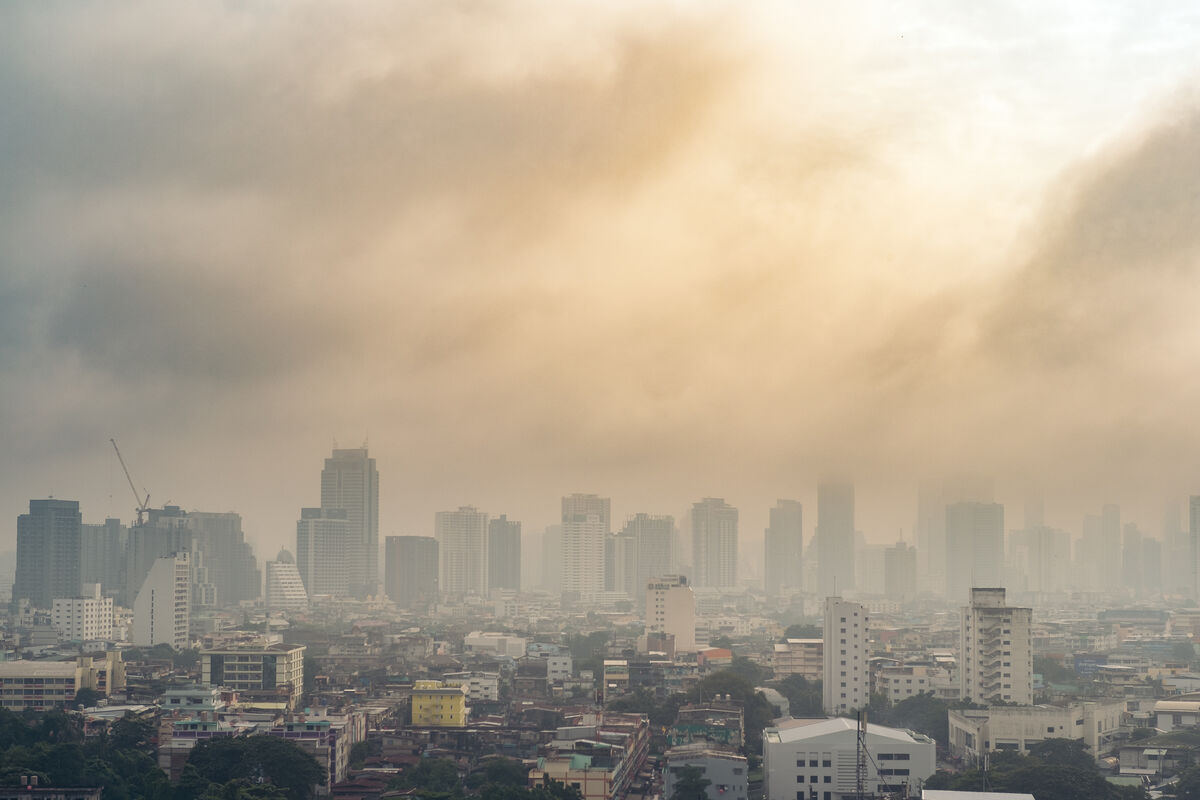Environmental issues such as climate change and water and air pollution affect natural environments. These issues also have a major impact on vulnerable populations and people living in fragile environments.
Global warming is causing glaciers, including polar ice caps, to melt and sea levels to rise. According to NASA, the sea level will rise by one metre in the next 100 to 200 years.
Rising sea levels threaten to submerge archipelagos (groups of islands) in the Pacific Ocean as well as coastal cities (located on continents, but on the seashore).

Waves and tides flooding part of a coastal town, San Jacinto, Ecuador
Source: Glenn R. Specht-grs photo, Shutterstock.com
More intense hurricanes and cyclones are a consequence of global warming. While climate change does not directly cause weather events such as hurricanes, it does increase their intensity, frequency or duration. These events greatly affect coastal cities.
In addition to hurricanes, cyclones and floods, record temperatures and more intense heat waves have been observed. This leads to an increase in the frequency of forest fires caused by dry weather and high temperatures.
According to climatologist Thomas Stocker, a member of the Intergovernmental Panel on Climate Change (IPCC), global warming is causing more rainfall in wet regions and less rainfall in dry regions.
Global warming increases the average temperature around the world over a long period of time. Greater temperature variations are also occurring. For instance, regions where the average temperature is higher are experiencing more intense heatwaves as well as periods of intense cold.

Forest fire in the autonomous community of Galicia, Spain, 2017.
Source : Brais Seara, Shutterstock.com
Heatwaves could eventually have consequences on human health. Heat can cause dehydration and even death from overheating. A study by the University of Hawaii identified 27 causes of death due to heatwaves.
These weather events could also extend the season for mosquitoes, which spread disease. Some World Health Organization (WHO) studies show that two billion more people could be at risk of dengue fever by 2080. To find out more about dengue fever (a viral infection transmitted by mosquitoes), visit the following site: Dengue and severe dengue.
Heatwaves are not the only thing that can have harmful impacts on health. Climate change affects air quality, water quality, drinking water availability, agricultural productivity (and therefore the amount of food available) and access to safe and clean housing that is not threatened by floods, hurricanes or other extreme weather. All of these important elements of human health are at risk due to climate change. The WHO claims that climate change is responsible for at least 150 000 deaths per year and this number is expected to reach 300 000 per year by 2030.
Water pollution also has an impact on ecosystems.
An ecosystem refers to the interactions between all the living species (animals and plants) in a natural environment. For example, a lake’s ecosystem contains water, mud, algae and fish. Other factors influence a lake’s environment, such as climate and pollution.
Groundwater, which is water found underground, is replenished by rain or snow. Groundwater supplies drinking water. If it becomes polluted, it is no longer drinkable and must be treated, which is an expensive and sometimes impossible process.
Some chemical pollutants found in water can cause illnesses or birth defects. This is more common in developing countries, where more people are forced to drink polluted water.
Flint, in the state of Michigan, made headlines in 2015 and 2016. For months, the city’s residents had been drinking tap water that was contaminated with lead.
But how did lead get into the water?
The city, which got its water from the Flint River, made budget cuts, which led to less effective water treatment, even though the river was more acidic than normal due to pollutants. Because the water was so acidic, as it passed through the city’s old lead pipes, it slowly destroyed the pipes and absorbed the lead.
This led to an outbreak of Legionnaires’ disease (a severe form of pneumonia) among residents. Children in the community had high levels of lead in their bodies, which can cause serious brain damage.
Other chemical pollutants in water can affect fish populations. For example, women who use birth control pills have more estrogen (a hormone that occurs naturally in women) in their urine. This hormone makes its way into the water, because it is not eliminated during water treatment. High concentrations of estrogen in the water cause some fish species to change from male to female. Pollutants that have the same effect as estrogen are also found in fungicides (pesticides), parabens and other preservatives used in cosmetics, medicines or food. There are indications that these substances can also have an impact on humans, such as reduced sperm production in men and increased breast tumours in women. These hormone disruptions can also impact the reproduction of some species.
Tributyltin (TBT) is mainly found in pesticides and in paints used to coat the hull of boats and has been banned in Canada since 2002. Why? Because once TBT is in the water, it has very harmful effects on ecosystems. Even in small amounts, TBT has caused female molluscs to develop male morphological characteristics, making them sterile. Some female fish also changed to male fish during early development stages.
France was the first country to ban the use of TBT on boats.
When water contains too much phosphorus and nitrogen of human origin, it accelerates the growth of plants such as algae. Algae consumes a lot of oxygen, often not leaving enough for other organisms in the water, causing them to die.
It is not common to drink polluted water in developed countries, since water is analyzed and purified, but it does occur from time to time. However, water pollution can indirectly impact human health. Fish, crustaceans and molluscs can absorb pollutants that are then ingested by humans. To prevent this type of poisoning, strict measures have been put in place for commercial fishing, but not for recreational fishing. Therefore, it is important to be aware of water quality and the potential risks when fishing.

Source : The Clay, Shutterstock.com
Carbon dioxide |(\text{CO}_2)| in the atmosphere is not only absorbed by trees, but also by the ocean. Too much |(\text{CO}_2)| in the water upsets its acid-base balance. With the |(\text{CO}_2)| generated by human activities, ocean acidification could reach 120% by 2060.
Acidification has a major impact on marine life: stunted growth and survival of sea urchins, starfish, mussels, lobsters, coral reefs and plankton (which form the basis of many food chains) and reduced habitat and food available for fish.
Air pollution affects many parts of the global ecosystem including soil, water, vegetation and animals.
One consequence of air pollution is acid rain. This rain is more acidic than normal rain. When certain gases are released into the atmosphere, they lower the pH of rainfall, making it more acidic. These gases can be released into the atmosphere naturally due to lightning, forest fires or volcanic eruptions, but human activity is also responsible.
Although it is called acid rain, it can also fall in the form of snow or hail.
Acid rain is the result of a chemical reaction between water and certain gases in the atmosphere such as carbon dioxide |(\text{CO}_2)|, sulphur dioxide |(\text{SO}_2)| and nitrogen oxide |(\text{N_2O})|. When these gases react with water, they form carbonic acid, sulphuric acid and nitric acid respectively.
Air pollution also reduces biodiversity and vegetation productivity. Acid rain is harmful to agriculture, forests and fishing. It depletes the soil, which slows down the growth of plants when they no longer have enough nutrients. Acid rain also reduces the number of fish available for fishing and other animals that feed on them.
Before falling to the ground, acid rain also contributes to the formation of smog. Smog is a mixture of air pollutants in the form of a thick haze or an invisible cloud. Smog can aggravate lung and heart problems and cause death in vulnerable populations.
Air pollution leads to poor air quality, which also affects human health. Health issues such as asthma, lung cancer, allergies and heart disease are linked to air pollution. It can also impact cognitive development. According to a 2016 WHO estimate, 600 000 children under the age of 15 died as a result of severe respiratory tract infections caused by air pollution. This air pollution occurred both indoors (due to fossil fuels used for cooking) and outdoors.

Source : nEwyyy, Shutterstock.com
As mentioned above, climate change is causing an increase in the frequency of extreme weather events such as floods, cyclones and droughts. These events have a huge impact on certain populations, such as people living in coastal cities, in the Pacific Islands and in some developing countries. In 2019, the World Bank predicted that by 2050, these natural disasters will cause the displacement of 143 million people if no action is taken to fight climate change.
The degradation of soil used for agriculture and ecosystems, in addition to the depletion of precious natural resources, such as freshwater, is causing some people to migrate, creating a new type of refugee: the climate refugee. This concept is not recognized by the 1951 Geneva Convention, which did not foresee a climate crisis as a valid threat for seeking asylum. However, the UN Human Rights Committee has stated that refusing an asylum seeker because of a climate crisis could be an infringement of the right to asylum. Unfortunately, this opinion has no political weight and governments are not required to adhere to it.
In 2015, a thousand people from an island in the Marshall Islands in the Pacific sought climate asylum in the United States due to the threat of rising waters that threatened to engulf the island. The island residents are trapped by unprecedented huge tides and raging storms. Flooding and increased salinity of the land (due to the flooding of ocean water) pose a major threat to agriculture and drinking water supplies.
In 2015, Ioane Teitiota was expected to become the world’s first climate refugee, but his asylum application was denied. He was from the Pacific nation of Kiribati and felt threatened by the rising waters. Entire areas of the archipelago are regularly flooded by the ocean, causing salt water to seep into the drinking water supply. He applied for asylum in New Zealand, which denied him refugee status on climatic grounds.
Some populations are more affected by environmental issues than others.
Many developing countries are more affected by environmental issues than developed countries. The population living in these countries relies heavily on their natural environment. They also lack the means and resources to adapt or rebuild in the face of climate change. They are most affected by crop failure and rising food prices due to extreme weather events. They do not have the same financial and technological resources as wealthier countries.
The African continent is likely to be the hardest hit by climate change. Its populations are already more exposed to insect-borne diseases and more mosquitoes would make the situation worse. Drought in Africa could have a significant impact on the food security and water supply of millions of people due to reduced agricultural productivity. Food prices could increase by 12% by 2030 and 70% by 2080 which would also greatly affect food security. To find out more about the impact of climate change in Africa, check out the following IPCC report: IPCC Special Report on Climate Change and Land.
Because climate change affects basic needs in poor countries, many people see the risk of increased conflict over access and control of resources.
Békri, K. (2009, mai). Étude du métabolisme du tributylétain par chromatographie liquide-spectrométrie de masse. Université de Québec à Rimouski. http://semaphore.uqar.ca/id/eprint/111/1/Khalida_Bekri_mai2009.pdf
Bernatchez, J.-S. (2020, 20 janvier). Quel statut pour les réfugiés climatiques?. Radio-Canada. https://ici.radio-canada.ca/premiere/emissions/l-heure-du-monde/segments/entrevue/151769/refugie-climatique-onu-giec-hdm
Eaufrance. (2019, 11 avril). Les impacts de la pollution de l'eau. https://www.eaufrance.fr/les-impacts-de-la-pollution-de-leau
Gouvernement du Canada. (2020, 30 septembre). Changements de la température. https://www.canada.ca/fr/environnement-changement-climatique/services/indicateurs-environnementaux/changements-temperature.html
Gouvernement du Canada. (2020, 2 octobre). Le smog et votre santé. https://www.canada.ca/fr/sante-canada/services/qualite-air/smog-et-votre-sante.html
Gouvernement du Canada. (2018, 27 juin). Pluies acides : causes et effets. https://www.canada.ca/fr/environnement-changement-climatique/services/pollution-atmospherique/enjeux/pluies-acides-causes-effets.html
Gouvernement du Canada. (2016, 28 juin). Tributylétains. https://www.ec.gc.ca/toxiques-toxics/default.asp?lang=Fr&n=C608DAAE-1
Gouvernement du Québec. (s.d.). Eaux souterraines. http://www.environnement.gouv.qc.ca/eau/souterraines/
Gouvernement du Québec. (s.d.). Rapport sur l'état de l'eau et des écosystèmes aquatiques au Québec. http://www.environnement.gouv.qc.ca/rapportsurleau/Etat-eau-ecosysteme-aquatique-qte-eau-Quelle-situation_NappeH2OSouterraine.htm
Groupe d'éducation et d'écosurveillance de l'eau - G3E. (s.d.). Santé humaine et pollution de l'eau. https://www.g3e-ewag.ca/ressources-interactives/capsules/eau_societe/sante_pollution_eau.html#:~:text=Impacts%20sur%20l'organisme%20humain,cas%20dans%20les%20bases%20militaires
Jardin, É. (2020, 10 septembre). Voici 14 conséquences concrètes du réchauffement climatique. CNEWS. https://www.cnews.fr/monde/2020-05-28/voici-13-consequences-concretes-du-rechauffement-climatique-715454
Kasotia, P. (s.d.). Les effets du réchauffement climatique sur la santé : Les pays en développement sont les plus vulnérables. L'Organisation des Nations Unies. https://www.un.org/fr/chronicle/article/les-effets-du-rechauffement-climatique-sur-la-sante-les-pays-en-developpement-sont-les-plus
Laurent, S. (2016, 4 février). Flint : les noces empoisonnées de l'austérité et du racisme. Libération. https://www.liberation.fr/planete/2016/02/04/flint-les-noces-empoisonnees-de-l-austerite-et-du-racisme_1431082
L'Organisation des Nations Unies. (2019, 4 aout). Migrations et crise climatique : l'ONU cherche des solutions. https://news.un.org/fr/story/2019/08/1049011
Libération et coll. (2016, 22 janvier). De Michael Moore à Barack Obama, l'eau empoisonnée de Flint émeut les États-Unis. https://www.liberation.fr/planete/2016/01/22/de-michael-moore-a-barack-obama-l-eau-empoisonnee-de-flint-emeut-les-etats-unis_1428347
Organisation mondiale de la santé. (2018, 1 février). Changement climatique et santé. https://www.who.int/fr/news-room/fact-sheets/detail/climate-change-and-health
Organisation mondiale de la santé. (2018, 29 octobre). Plus de 90 % des enfants dans le monde respirent chaque jour un air pollué. https://www.who.int/fr/news-room/detail/29-10-2018-more-than-90-of-the-world%E2%80%99s-children-breathe-toxic-air-every-day
Québec Océan. (2018, janvier). L'acidification des océans. http://www.quebec-ocean.ulaval.ca/pdf_xls_files/Fiche4.pdf
Radio-Canada. (2019, 14 juin). Eau contaminée à Flint, au Michigan : abandon des poursuites et reprise de l'enquête. https://ici.radio-canada.ca/nouvelle/1185936/etats-unis-flint-eau-plomb-abandon-poursuites
Shirota, L. M. (2017, 9 novembre). Brace yourself for coming heatwaves, there are at least 27 ways they can kill you. University of Hawaii. http://www.hawaii.edu/news/article.php?aId=8913